Are you tired of manually installing Python packages in your Docker images? Do you want to streamline your CI/CD pipeline with Cloud Build? Look no further! In this article, we’ll show you how to install the Artifact Registry Python package from a Dockerfile using Cloud Build. Buckle up, because we’re about to take your containerization skills to the next level!
- What is Artifact Registry and why do I need it?
- Prerequisites
- Step 1: Create an Artifact Registry repository
- Step 2: Create a service account and generate a JSON key file
- Step 3: Configure your Cloud Build environment
- Step 4: Install the Artifact Registry Python package in your Dockerfile
- Step 5: Configure your Dockerfile to use Artifact Registry
- Step 6: Build your Docker image with Cloud Build
- Troubleshooting common issues
- Conclusion
What is Artifact Registry and why do I need it?
Artifact Registry is a fully managed repository service provided by Google Cloud that allows you to store, manage, and deploy your container images and language packages. By using Artifact Registry, you can simplify your development process, improve collaboration, and reduce costs. With Artifact Registry, you can:
- Store and manage your container images in a single location
- Use a consistent and reliable package manager
- Scale your development process with ease
- Integrate with other Google Cloud services, such as Cloud Build and Cloud Run
Prerequisites
Before we dive into the tutorial, make sure you have the following:
- A Google Cloud account with the Artifact Registry API enabled
- A Dockerfile for your Python application
- A Cloud Build configuration file (cloudbuild.yaml)
- A basic understanding of Docker and Cloud Build
Step 1: Create an Artifact Registry repository
First, you need to create an Artifact Registry repository to store your Python package. Follow these steps:
- Go to the Google Cloud Console and navigate to the Artifact Registry page
- Click on “Create Repository” and select “Python” as the package type
- Enter a unique repository name and description
- Click “Create” to create the repository
Step 2: Create a service account and generate a JSON key file
To authenticate with Artifact Registry from your Cloud Build environment, you need to create a service account and generate a JSON key file. Follow these steps:
- Go to the Google Cloud Console and navigate to the IAM & Admin page
- Click on “Service accounts” and then “Create Service Account”
- Enter a service account name and description
- Click “Create” to create the service account
- Click on the three vertical dots next to the service account email and select “Create key”
- Select “JSON” as the key type and click “Create”
- Download the JSON key file and save it securely
Step 3: Configure your Cloud Build environment
To use Artifact Registry with Cloud Build, you need to configure your environment to authenticate with the service account and use the JSON key file. Follow these steps:
steps:
- name: 'gcr.io/cloud-builders/gcloud'
args: ['auth', 'activate-service-account', '--key-file=key.json', '--project-id=$PROJECT_ID']
- name: 'gcr.io/cloud-builders/gcloud'
args: ['config', 'set', 'artifacts/repository', 'your-repository-name']
Replace `key.json` with the path to your JSON key file, and `your-repository-name` with the name of your Artifact Registry repository.
Step 4: Install the Artifact Registry Python package in your Dockerfile
Now, you can install the Artifact Registry Python package in your Dockerfile using the following command:
RUN pip install --upgrade google-cloud-artifactregistry
This command installs the latest version of the Artifact Registry Python package.
Step 5: Configure your Dockerfile to use Artifact Registry
To use Artifact Registry with your Dockerfile, you need to configure your environment to authenticate with the service account and use the JSON key file. Follow these steps:
ENV GOOGLE_APPLICATION_CREDENTIALS=/path/to/key.json ENV CLOUDSDK_CORE_PROJECT_ID=$PROJECT_ID ENV CLOUDSDK_CORE_REGION=$REGION RUN pip install --upgrade google-cloud-artifactregistry RUN echo $GOOGLE_APPLICATION_CREDENTIALS > /root/.gcloud/application_default_credentials.json RUN gcloud auth activate-service-account --key-file=$GOOGLE_APPLICATION_CREDENTIALS RUN gcloud config set artifacts/repository your-repository-name
Replace `/path/to/key.json` with the path to your JSON key file, `$PROJECT_ID` with your Google Cloud project ID, `$REGION` with the region of your Artifact Registry repository, and `your-repository-name` with the name of your Artifact Registry repository.
Step 6: Build your Docker image with Cloud Build
Finally, you can build your Docker image with Cloud Build using the following command:
gcloud builds submit --config=cloudbuild.yaml .
This command submits your Cloud Build configuration file (cloudbuild.yaml) and builds your Docker image using the instructions in your Dockerfile.
Troubleshooting common issues
If you encounter any issues during the installation process, refer to the following troubleshooting tips:
| Error | Solution |
|---|---|
| Authentication issues | Check that your JSON key file is in the correct location and that the service account has the necessary permissions. |
| Package installation issues | Check that you have the latest version of pip installed and that the Python package is compatible with your environment. |
| Cloud Build configuration issues | Check that your Cloud Build configuration file is correctly formatted and that the service account has the necessary permissions. |
Conclusion
In this article, we’ve shown you how to install the Artifact Registry Python package from a Dockerfile using Cloud Build. By following these steps, you can streamline your CI/CD pipeline and simplify your development process. Remember to correctly configure your environment, authenticate with Artifact Registry, and troubleshoot common issues.
With Artifact Registry and Cloud Build, you can take your containerization skills to the next level and focus on building amazing applications. Happy building!
_KEYWORD: Install Artifact Registry Python package from Dockerfile with Cloud Build_
Frequently Asked Question
Got questions about installing Artifact Registry Python package from Dockerfile with Cloud Build? We’ve got answers!
What is Artifact Registry and why do I need it?
Artifact Registry is a fully-managed repository that allows you to securely store, manage, and version control your software packages, including Python packages! You need it to securely store and manage your Python packages for your Docker images, and it’s a great way to ensure consistency and reproducibility across your builds.
How do I install the Artifact Registry Python package from my Dockerfile?
You can install the Artifact Registry Python package from your Dockerfile by adding the following line: `RUN pip install –upgrade google-cloud-artifactregistry`. This will install the package and its dependencies, and you’ll be ready to use it in your build process!
What’s the benefit of using Cloud Build with Artifact Registry?
By using Cloud Build with Artifact Registry, you can automate your build process, store your artifacts securely, and track changes to your code. It’s a powerful combination that helps you build, test, and deploy your applications faster and more reliably!
Do I need to authenticate with Artifact Registry from my Dockerfile?
Yes, you need to authenticate with Artifact Registry from your Dockerfile using credentials or service accounts. You can do this by setting the `GOOGLE_APPLICATION_CREDENTIALS` environment variable or by using the `gcloud` command-line tool to authenticate. This ensures that your build process can access the Artifact Registry securely.
Can I use Artifact Registry with other CI/CD tools besides Cloud Build?
Yes, you can use Artifact Registry with other CI/CD tools besides Cloud Build! Artifact Registry is designed to work with a variety of tools and frameworks, including Jenkins, GitLab CI/CD, and CircleCI. Just make sure to check the documentation for your specific tool to see how to integrate it with Artifact Registry.


